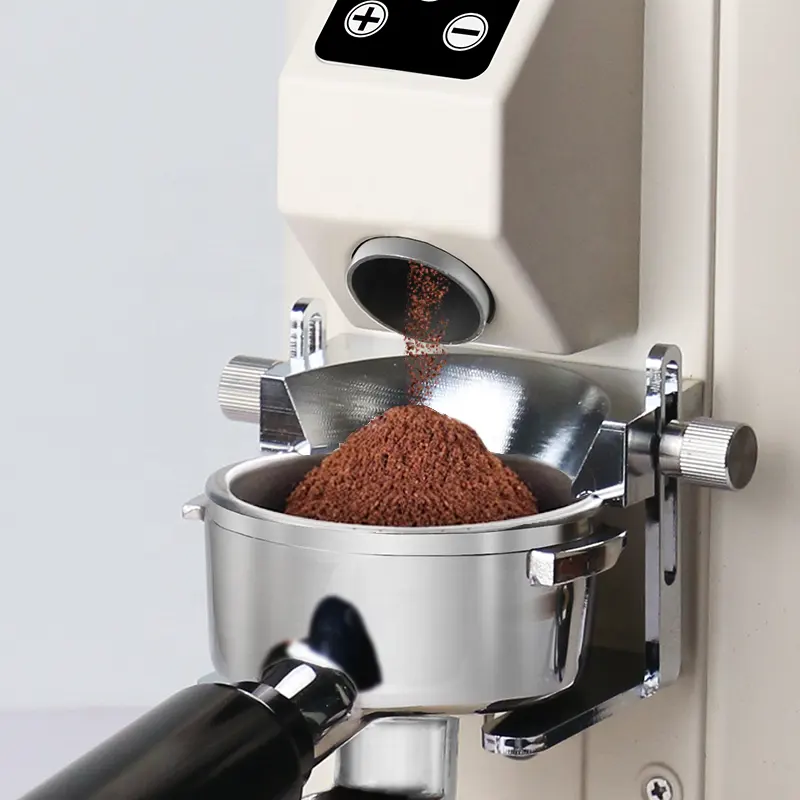The main methods for testing the grinding uniformity of coffee grinders are as follows:
First, the sieve method
This is the most commonly used method for precisely measuring the grinding degree of coffee and is also applicable to the test of grinding uniformity.
Prepare the sieves: Prepare several sieves marked with different mesh sizes. Usually, 3 to 4 sieves are used, with the mesh sizes decreasing in sequence.
Grinding coffee: Use a coffee grinder to grind a certain amount of coffee beans to obtain coffee powder.
Sieving coffee grounds: Place the ground coffee grounds above the largest sieve, then gently shake the sieve to allow the larger particles of coffee grounds to pass through the mesh and fall into the next sieve. Repeat this step until all the particles are separated out.
Weighing and calculation: Weigh out the coffee grounds in each sieve and calculate the percentage of coffee grounds in each sieve. The uniformity of grinding can be evaluated by comparing the distribution of coffee grounds on different sieves.
Second, particle size analysis method
Particle size analysis assesses grinding uniformity by measuring the particle size distribution of coffee grounds.
Preparation tools: A calibration paper and a mobile phone or a professional particle size analyzer are required.
Grinding coffee: Use a coffee grinder to grind a certain amount of coffee beans to obtain coffee powder.
Photo analysis: Evenly sprinkle the coffee powder on the calibration paper to ensure even coverage. Take photos in well-lit conditions and then upload them to the designated particle size analysis website or use a professional particle size analyzer for analysis.
Interpretation result: The analysis software or instrument will generate a particle size distribution map of coffee powder. By observing the uniformity of the particle size distribution, the uniformity of grinding can be evaluated.
Third, the card label method
Although the card label method is mainly used to measure the extraction efficiency of coffee, to a certain extent, it can also reflect the uniformity of grinding.
Prepare containers: Prepare cups or containers marked with 10 to 12 different labels.
Grinding and brewing: Use a coffee grinder to grind a certain amount of coffee beans. Then, put the ground coffee powder into a container and gradually pour in water with a tea dispenser. The amount of water added should be 2 to 2.5 times the weight of the coffee powder.
Observation and Evaluation: After waiting for a period of time (such as 30 seconds), observe the clarity of the coffee liquid and the condition of suspended particles. If the coffee liquid is clear and the suspended particles are uniform, it can to some extent indicate that the grinding uniformity is good. However, it should be noted that this method is influenced by multiple factors, such as the fineness of the coffee grounds and the brewing method, and thus can only be used as an auxiliary evaluation means.
Fourth, professional testing institutions conduct tests
To ensure the accuracy of grinding uniformity, the coffee grinder can also be sent to a professional testing institution for testing. Professional testing institutions are usually equipped with advanced testing equipment and professional technicians, and are capable of precisely measuring and evaluating the grinding uniformity of coffee grinders in accordance with relevant standards and norms.
Precautions
Consistent test conditions: When conducting the uniformity test of grinding, it is necessary to ensure that the conditions for each test are consistent, including the type of coffee beans, the Settings of the grinding machine, grinding time, etc., to ensure the accuracy of the test results.
Take the average of multiple tests: As the grinding process may have a certain degree of randomness, it is recommended to conduct multiple tests and take the average as the final result.
Evaluation in combination with other indicators: The uniformity of grinding is only one aspect of evaluating the performance of a coffee grinder. It should also be comprehensively evaluated in combination with other indicators such as grinding fineness, grinding speed, and noise level.
Through the above methods, the grinding uniformity of the coffee grinder can be comprehensively and accurately evaluated, providing a reference basis for the selection and use of the coffee grinder.


